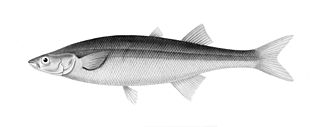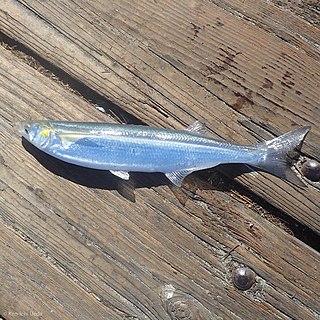
The Old World silversides are a family, Atherinidae, of fish in the order Atheriniformes. They occur worldwide in tropical and temperate waters. About two-thirds of the species are marine, and the remainder live in fresh water. The 74 species are in 13 genera. The genus Craterocephalus is the most diverse with 25 species. Four genera are monotypic.
Menidia is a genus of Neotropical silversides native to freshwater, brackish and marine habitats along the Atlantic and Gulf of Mexico coasts of North America, ranging from the Gulf of Saint Lawrence in Canada to the Yucatán Peninsula in Mexico. The species M. clarkhubbsi, an all-female species, reproduces asexually.

Atherinomorus is a genus of silversides in the family Atherinidae.

Atherina is a genus of fish of silverside family Atherinidae, found in the temperate and tropic zones. Up to 15 cm long, they are widespread in the Mediterranean, Black Sea, Sea of Azov in lagoons and estuaries. It comes to the low stream of the Dnieper, Southern Bug, Dniester and Danube Rivers.

Basilichthys is a genus of Neotropical silversides native to freshwater habitats in Chile and Peru. Many species now placed in Odontesthes were formerly included in Basilichthys instead.

Chirostoma is a genus of Neotropical silversides from the Lerma River basin in Mexico, including lakes Chapal and Pátzcuaro. Fish in the genus collectively go by the common name charal/charales in their native range. They are heavily fished, but several of the species have become threatened due to habitat loss, introduced species and overfishing. Three species are considered extinct: C. bartoni, C. charari (1957) and C. compressum (1900). Four others have not been recorded recently and may also be extinct.
Paratherina is a genus of sailfin silversides endemic to the Indonesian island of Sulawesi.
Poblana is a genus of Neotropical silversides that are endemic to Mexico, with each of the four threatened species restricted to a single Oriental Basin maar lake. They are small fish that do not surpass 8 cm (3 in) in standard length.
Kestratherina is a genus of silversides endemic to the eastern Indian Ocean off southern Australia.
Atherinosoma is a genus of silversides from the coastal waters of south-eastern Australia.

Hypoatherina is a genus of silversides in the family Atherinidae.
Leptatherina is a genus of silversides, one freshwater and one marine, native to Australia.

Atherinella is a genus of Neotropical silversides from freshwater, brackish and marine habitats in Mexico, Central America and South America.

Atherinopsis californiensis, the jack silverside or jacksmelt, is a species of neotropical silverside native to the Pacific coast of North America from Oregon, United States to southern Baja California, Mexico. This species grows to 45 cm (18 in) in total length and is important commercially as a source of human food. It is the only known member of its genus. The adults occur in inshore areas, such as bays. They form schools. This species is a demersal spawners in inshore habitats, it is oviparous and the larvae are planktonic, living at the very surface of the water and feeding on phytoplankton. The eggs are attached to one another and to the substrate by adhesive filaments in the chorion.
Colpichthys is a genus of Neotropical silverside endemic to the Gulf of Mexico.
Membras is a genus of fish, Neotropical silversides, from freshwater, brackish water and marine habitats along coastal parts of the Americas.
Iso is an Indo-Pacific genus of silversides, commonly called surf sardines, the only genus in the monogeneric family Isonidae, they were formerly classified in the family Notocheiridae alongside the surf silverside but they are now thought to be within the suborder Atherinoidei while the surf silverside is classified in the suborder Atherinopsoidei, along with the Neotropical silversides. It contains five species to date, the first of which was described in 1895.

Atherinomorinae is a subfamily of silversides from the family, Atherinidae, the Old World silversides.









